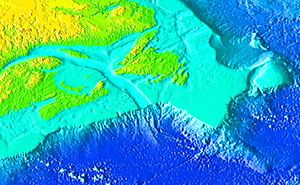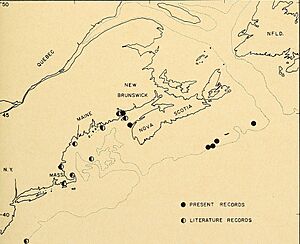Scotian Shelf facts for kids
The Scotian Shelf is a huge underwater area, like a wide, shallow shelf, located off the coast of Nova Scotia, Canada. It's part of the larger Continental shelf that extends from the land into the ocean. This amazing place covers about 120,000 square kilometers, stretching for 700 kilometers. It's between 120 and 240 kilometers wide, and the water here is usually about 90 meters deep.
This area is super important for nature, especially for the ocean creatures that live there. It's known as the Scotian Shelf Large Marine Ecosystem.
The Scotian Shelf has clear edges. To the northeast, it drops down to 400 meters into the Laurentian Channel. Further south, the ocean floor plunges sharply to more than 3,000 meters deep. To the southwest, it meets the Northeast Channel, which includes the Gulf of Maine.
The Scotian Shelf has many interesting features. It has shallow, flat areas called banks, which are usually 25 to 100 meters under the ocean surface. Between these banks are deeper spots called basins and troughs, which can be 160 to 300 meters deep. One famous spot is Sable Island, which is part of these banks.
Ocean Currents and Water Flow
Water moves across the Scotian Shelf in different ways. A current flows southwest over the inner part of the shelf. Sometimes, this current even carries water from the Gulf of Saint Lawrence. The water flow over the shallow banks is usually weaker and changes more often.
There's a very deep underwater canyon on the Scotian Shelf called "The Gully". It's more than 1,000 meters deep! Currents flow through this canyon towards the south. This mixes the deep ocean water with the Nova Scotia Current. This mixing helps more plants and animals grow, especially towards the eastern part of the shelf.
The Scotian Shelf is also greatly affected by the Gulf Stream. This strong ocean current brings warm water from further south. Because of this, you can find many marine animals here that usually live in warmer waters. These animals appear regularly when warm water swirls off the main Gulf Stream.
Amazing Marine Life

The Scotian Shelf Large Marine Ecosystem is full of life! It's home to many different kinds of shellfish and fish. These animals use the area as a safe place to lay their eggs and for their young to grow. Because there are so many fish, the Scotian Shelf is one of the most important fishing areas in the Atlantic Ocean.
One very special animal found here is the right whale. They have a critical habitat in the Roseway Basin, which is in the northeastern part of the Scotian Shelf. About 30 percent of all known right whales use this area at some point during the year.
Another unique whale, the northern bottlenose whale, also lives in the Scotian Shelf Waters. Many of them, about 230 individuals, have been seen in The Gully canyon. Other marine mammals like the sperm whale and harbour seal also live here. The grey seal is very common on Sable Island.
Many different kinds of birds use the coastal areas of the Scotian Shelf. They stop here during their long migrations. Out in the open ocean, you can see birds like shearwaters, sea ducks (such as the common eider), and alcids (like dovekies and murres).


